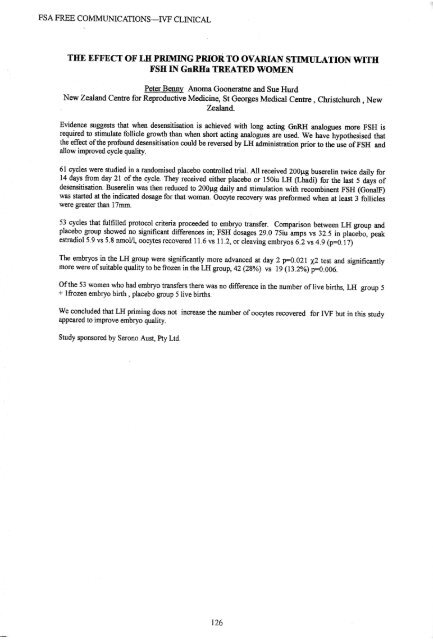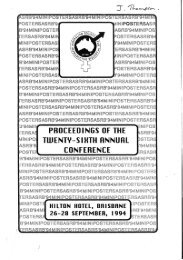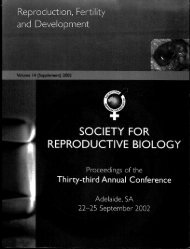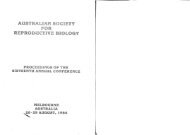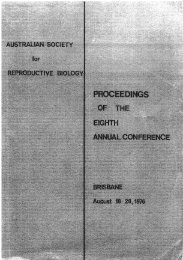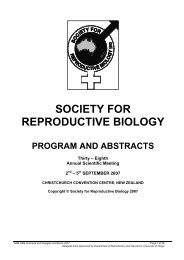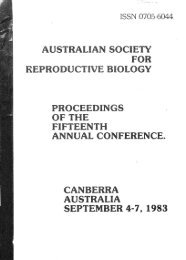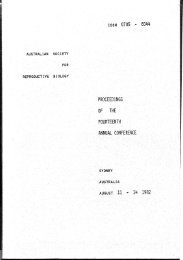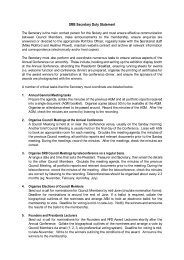ruoounu. nnSlunCIS&UINI-rOSIlnS - the Society for Reproductive ...
ruoounu. nnSlunCIS&UINI-rOSIlnS - the Society for Reproductive ...
ruoounu. nnSlunCIS&UINI-rOSIlnS - the Society for Reproductive ...
You also want an ePaper? Increase the reach of your titles
YUMPU automatically turns print PDFs into web optimized ePapers that Google loves.
FSA FREE COMMUNICATIONS-IVF CLINICALFSA FREE COMMUNICATIONS-IVFCLINICALTHE EFFECT OF LH PRIMING PRIOR TO OVARIAN STIMULATION WITHFSH IN GnRHa TREATED WOMENPeter Benny Anoma Gooneratne and Sue HurdNew Zealand Centre <strong>for</strong> <strong>Reproductive</strong> Medicine, St Georges Medical Centre, Christchurch, NewZealand.Evidence suggests that when desensitisation is achieved with ·long acting GnRH analogues more FSH isrequired to stimulate follicle growth than when short acting analogues are used. We have hypo<strong>the</strong>sised that<strong>the</strong> effect of<strong>the</strong> profound desensitisation could be reversed by LH administration prior to <strong>the</strong> use ofFSH andallow improved cycle quality.61 cycles were studied in a randomised placebo controlled trial. All received 200J.1g buserelin twice daily <strong>for</strong>14 days from day 21 of<strong>the</strong> cycle. They received ei<strong>the</strong>r placebo or 150iu LH (Lhadi) <strong>for</strong> <strong>the</strong> last 5 days ofdesensitisation. Buserelin was <strong>the</strong>n reduced to 200llg daily and stimulation with recombinent FSH (GonalF)was started at <strong>the</strong> indicated dosage <strong>for</strong> that woman. Oocyte recovery was pre<strong>for</strong>med when at least 3 follicleswere greater than 17mm.53 cycles that fulfilled protocol criteria proceeded to embryo transfer. Comparison between LH group andplacebo group showed no significant differences in; FSH dosages 29.0 75iu amps vs 32.5 in placebo, peakestradiol 5.9 vs 5.8 nmolll, oocytes recovered 11.6 vs 11.2, or cleaving embryos 6.2 vs 4.9 (p=0.17)The embryos in <strong>the</strong> LH group were significantly more advanced at day 2 p=O.021 X2 test and significantlymore were ofsuitable quality to be frozen in <strong>the</strong> LH group, 42 (28%) vs 19 (13.2%) p=0.006.Of<strong>the</strong> 53 women who had embryo transfers <strong>the</strong>re was no difference in <strong>the</strong> number oflive births, LH group 5+ 1frozen embryo birth, placebo group 5 live births.We concluded that LH priming does not increase <strong>the</strong> number ofoocytes recovered <strong>for</strong> IVF but in this studyappeared to improve embryo quality.Study sponsored by Serono Aust, Pty Ltd.A RETROSPECTIVE REVIEW OF LUTEAL PHASE HORMONE CONCENTRATIONS INWOMEN USING DIFFERENT FORMS OF LUTEAL SUPPORT FORASSISTEDREPRODUCTIONMazen Rawashdeh, Lija Arthur; 'Howard Smith, Peter illingworth'Department of<strong>Reproductive</strong> Medicine, Westmead Hospital.Current evidence suggests that <strong>the</strong> choice of luteal support between progesterone and hCG has limited effect on ARTconception rates provided sufficient progesterone is administered. (Akande etal, 1996). However many patientsrepoItdifficulty and discom<strong>for</strong>t in using progesterone pessaries. In this study, hormone concentrations were investigated in ol1derto check <strong>the</strong> absorption and hormonal consequences ofluteal support in a group ofwomen undergoing ART.All women were treated by standard ART long-downregulation protocol. HCG (1500 ill at three day intervals) was used<strong>for</strong> luteal support unless <strong>the</strong>re was evidence ofovarian hyperstimulation (>10, OOOpmol/L oestradio~ >15 oocytes collected,clinical suggestion or past history of OHSS) in which case progesterone pessaries (200mg x2 per day) were used. Allwomen located geographically close (n=I44) to <strong>the</strong> Westmead Fertility Centre, had a serum sample collected between Days7 and 10 of<strong>the</strong> luteal phase and stored <strong>for</strong> later assay. Each sample was assayed <strong>for</strong> progesterone, oestradiol and inhibin A.According to this protocol, 45 women used progesterone pessaries (10 conceived) and 99 women used hCG (21 conceived).The progesterone concentrations in <strong>the</strong> group using progesterone pessaries ranged from 47-742 nmollL (median 81nmol/L).The progesterone concentrations in <strong>the</strong> women using hCG ranged from 38-2525nmollL (median 376nmollL). 87 (87%) of<strong>the</strong> women receiving hCG had progesterone concentrations in excess of <strong>the</strong> reference range (mean+ 2SD) <strong>for</strong> <strong>the</strong>physiological menstrual cycle while 21 (48%) of <strong>the</strong> women receiving progesterone pessaries had progesteroneconcentrations in excess of <strong>the</strong> reference. The inhibin A concentrations in <strong>the</strong> group using progesterone pessaries variedfrom 4-649pg/mL (median 47pg/mL) and ranged from 16-1 I18pg/mL (median 272) in <strong>the</strong> group using hCG support. In <strong>the</strong>group using progesterone pessaries, 10 women (22.7%) had inhibin A concentrations below <strong>the</strong> reference range <strong>for</strong> <strong>the</strong>normal menstrual cycle.Conclusions:All women using progesterone pessaries were found to have progesterone concentrations that are at least in <strong>the</strong>physiological range with only a few having extreme supra-physiological concentrations. Most women using hCG lutealsupport have significantly supra-physiological progesterone concentrations. Endogenous luteal hormone output issuppressed in approximately 23% of women using progesterone pessaries with some cases exhibiting no detectableendogenous luteal function. The clinical significance of<strong>the</strong>se endocrine variations is not clear.126127


